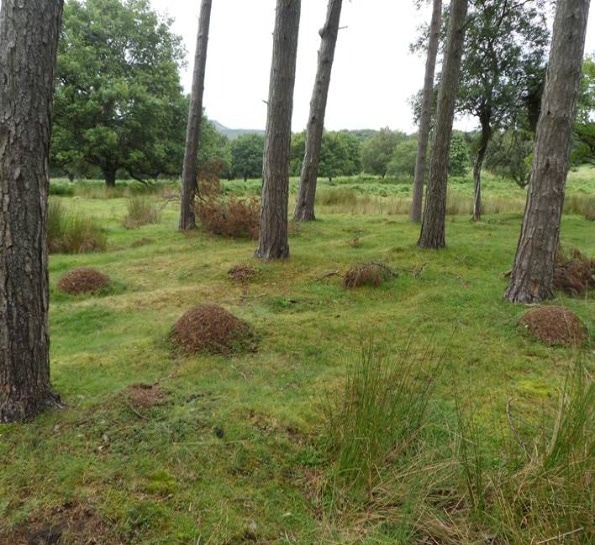Cooperating with neighbors, particularly distant relatives, can be an efficient evolutionary strategy, according to new research.
 Professor Robinson studied wood ant nests in Derbyshire. Image Credit: University of York.
Professor Robinson studied wood ant nests in Derbyshire. Image Credit: University of York.
According to the research, social animals that work very closely with their closest neighbors to repel other groups have a better chance of their genes surviving since those neighbors are likely to be carrying the same genes as well.
A group of researchers from the United Kingdom and the United States created a mathematical model to describe unusual behavior observed in ants and primates. Even though most species are extremely competitive and combat with neighboring groups, some will collaborate and actively share resources with their neighbors.
Highly aggressive
Professor Elva Robinson of the University of York’s Department of Biology witnessed this phenomenon while studying groups of wood ant nests in Derbyshire for the past decade.
Wood ants are known to be highly aggressive, spraying acid if ants from other nests encroach on their territory. Yet sometimes multiple nests live peacefully side by side in the same ‘colony,’ fighting off outsider ants that come near. The colonies I study have taken this one step further in that they also share food between nests. Some nests gather no food themselves, but rely purely on food supplied by workers from other nests.”
Elva Robinson, Professor, Department of Biology, University of York
Most primates are aggressively territorial, and only bonobos and humans have been known to share resources in this way. Bonobos will meet neighboring groups at the boundaries of their territory to exchange high value food such as meat.
Reducing conflict
Professor Robinson collaborated with co-workers Dr António Rodrigues of Yale University and Dr Jessica Barker of Aarhus University and the University of Alaska Anchorage to describe how this level of collaboration could occur and what benefits it might provide to those involved.
They came up with the following hypothesis. For starters, plentiful food increases the size of the group while decreasing the conflict among its members. When offspring migrate away to form satellite groups, they do not really travel far to stay close to food sources.
Kinship and abundant resources result in little conflict between these disparate but related groups, and it is in their best interests to keep new groups from settling nearby. Finally, resource sharing ensures that all cooperating groups thrive.
Dr Rodrigues developed a model that can mathematically evaluate the evolutionary impacts of different levels of cooperation to test this hypothesis. The model enables the scientist to experiment with various variables, such as how far the offspring move away from the parent group, to see how they affect the outcome.
Staying close
It’s not possible to manipulate these variables in the field, so the only way to see if the theory makes sense is to create this kind of model. Using the model, we can also see how groups could benefit from this kind of cooperation, particularly in terms of ensuring the survival of their genes.”
Dr António Rodrigues, Yale University
The researchers discovered that when offspring remained close to the main group, it was beneficial for all involved to cooperate and inhibit others from entering the area. Even if fighting an aggressor with the neighbors killed everyone in the group, the genes would still have a better chance of passing down to more distant relatives.
Evolutionary advantage
Dr Barker investigates human behavior but cautions against extrapolating the findings to levels of cooperation and aggression among human groups.
Our model looks at the evolutionary benefits of behavior over a long timescale, rather than the decisions we make over shorter timescales to unconsciously maximize such evolutionary advantages. Where the model might have relevance is in trading between early humans, where groups might more readily trade with nearby groups that were related, rather than those where there was no familial connection. That probably would have provided an evolutionary advantage to those families, and still seems likely to us today.”
Dr Jessica Barker, Aarhus University
Source:
Journal reference:
Rodrigues, A. M. M., et al. (2023) The evolution of intergroup cooperation. Philosophical Transactions of the Royal Society B. doi.org/10.1098/rstb.2022.0074.